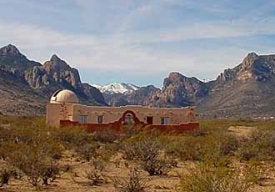
Many folks seeking a remedy to light pollution and climate woes have taken up residence in good locations for astronomy. Astronomical neighborhoods have popped up near Cloudcroft, New Mexico, and Chiefland, Florida, for example. The country’s most ambitious astronomical development, however, is the 430-acre, master-planned Arizona Sky Village, which lies in the southeast corner of Arizona near the New Mexico border. When completed, 74 individual homes and 11 time-share residences will occupy an expanse of high desert. Several dozen homes will be built there by the end of 2005.
Arizona Sky Village is the vision of its first residents, Jack Newton and Gene Turner. A leading astro-imager for decades, Newton is a household name among amateur astronomers. Already he is besting his high standard of images from his observatory on the Sky Village site. Turner combines a lifelong fascination with astronomy with a career in real estate development as manager of the project. The property lies near the town of Portal, which also boasts daytime activities such as hiking and bird-watching in the nearby Chiricahua Mountains.
The sky above the development is only a couple tenths of a magnitude brighter than the most remote locations on Earth. Turner expects the adage, “There’s power in numbers,” will help the community preserve its dark-sky environment.
Southeastern Arizona has a dry, moderate climate characterized by insignificant winter snow and tolerable summer heat. Portal’s latitude (about 32°) lies far enough south to elude cold fronts; its longitude (109°) lies far enough west to remain dry. In two nights of observing at Arizona Sky Village, I had skies steady enough to view planets at magnifications in excess of 400x.
Developments such as Arizona Sky Village may be the future of dark-sky astronomy. Filling desirable locations with amateur astronomers can help keep light pollution at bay. For more information, visit the Arizona Sky Village web site.









